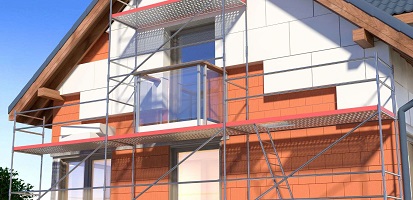
Traditional coats vs nanotechnology coats.
Traditional coats vs nanotechnology coats.
Is it possible to thermally insulate a wall without increasing its thickness?
Ing. Cristian Angeli 02/03/2022
Undoubtedly the most popular maintenance intervention in the condominium area is the one that involves the construction of the thermal coat. And it is understandable, given that the cost of energy in the last year has more than doubled.
Making a coat is simple, cheap and convenient, also because the shopping can take advantage of the 110% super concessions (eco-bonus). To do this, expanded polystyrene (or polystyrene or EPS) is usually used, which is the most widespread and also the most tested insulator for the insulation of buildings.
Except in extreme climatic zones, panels of variable thickness from 4 to 10-12cm are used, in relation to the characteristics of the building and the masonry package with which it is made. The thickness also depends on the energy class to be achieved and on the specific characteristics of the insulation.
In fact, even within the same material, for example polystyrene, there are product “ranges” of different quality and with specific values of thermal conductivity (*).
The application is relatively fast, as it is done from the outside by gluing and mechanically fixing the slabs on the pre-existing plaster. Then everything is covered by means of the so-called “smoothing”, that is a protection consisting of a special reinforcement mesh in turn finished with a very thin layer of adhesive mortar which, painted, gives the most desired exterior appearance.
Most of the Italian buildings, both new and renovated, have an insulation system of this type.
The problem of balconies
The realization of the thermal coat can sometimes create problems in correspondence of the balconies because, with its thickness, it narrows the walkable surface. In some cities, space is money and even a few centimeters less can create considerable discontent.
But there can also be other problems, since the walls of the balconies are often filled with utilities: boilers, condensing units, appliques, wardrobes, curtains, flower boxes and various furnishings.
Then it is necessary to take into account the necessary adaptations in correspondence with the windows, which can sometimes also affect the interiors.
In this regard, the recent judgments are now known which canceled condominium resolutions which, by approving the execution of the coat on the balconies (and therefore reducing the surface area of private parts in all respects), infringed the rights of the individual condominiums who had them. challenged.
On the contrary, the Court of Milan did not suspend a resolution that provided for the installation of the coat also in the exclusive properties only because the assembly decision expressly provided for the faculty for the dissenting condominium not to make the coat on their balcony by resorting to other solutions (Trib . Milan 13 August 2021).
There is a logic, because when energy efficiency is carried out in a building, the insulation must be homogeneous throughout the dispersing envelope and therefore the balconies must also be insulated, in one way or another.
Otherwise, the need for the community of condominiums would disappear, as the professional appointed by the assembly to design the insulations would hardly be able to make ends meet under the former law 10/91.
Centimeter more, centimeter less, the problems do not change
As an alternative to coats made with traditional materials, systems made with silica gel-based panels, also known as nano-coats, are spreading, which make it possible to reduce the thickness of the coating, with the same insulating performance.
There are various trademarks of these products, for whose definition and characteristics it may be appropriate to refer to the price lists officially recognized in Italy, for example the one published by DEI, which describes them as “airgel-based insulating panels, diffusion open and capillary diffusion ” having ” thermal conductivity equal to 0.015W / mK, coupled to a breathable polypropylene membrane “. The same price list specifies the costs inclusive of installation for thicknesses ranging from 6 to 60mm, which are n times higher than those of a coat of similar thermal characteristics made of expanded polystyrene panels.
Pros and cons as in all things.
The reflection – and the choice – must be shifted to the technical level.
It is true that the creation of a traditional coat takes away a bit of space, with all that follows, but it cannot be overlooked that even the (correct) use of avant-garde coats requires thicknesses of the order of some centimeter, and not a few millimeters as is sometimes said. One wonders therefore if it is worth it, considering not the thickness in absolute value, but the difference between the two.
As always, it is up to the professional to make the appropriate assessments, also in terms of product certification, taking into account the cost / benefit ratio.
Source: https://www.condominioweb.com/cappotti-tradizioni-vs-cappotti-nanotecnologi.19039
GECOSEI by Giuseppina Napolitano


